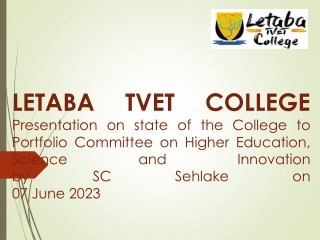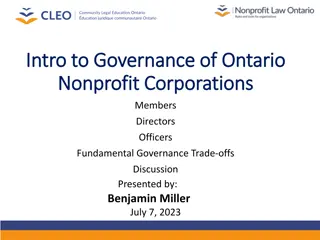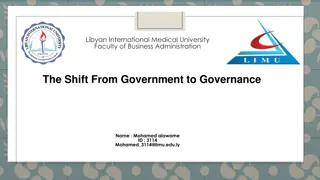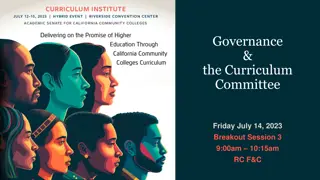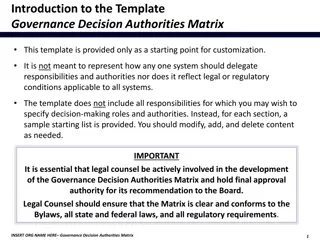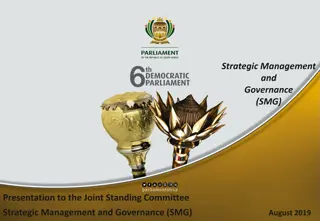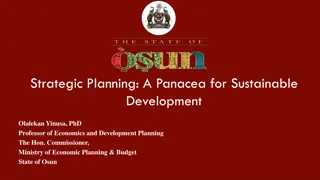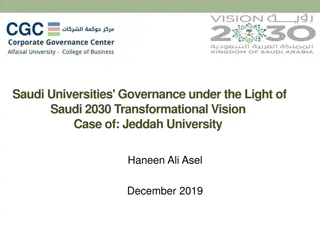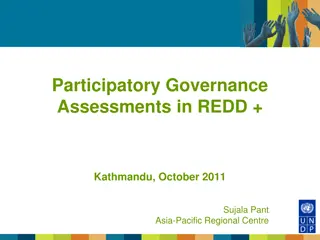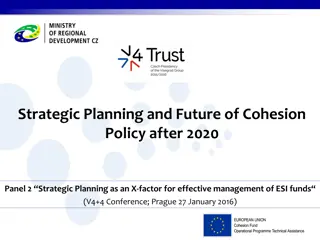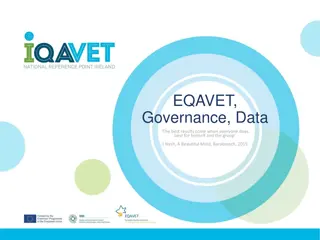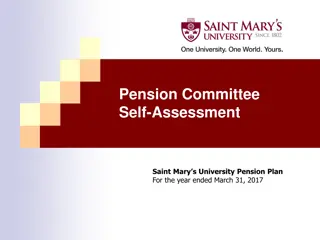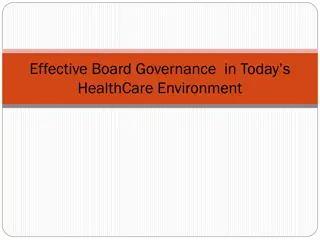Strategic governance
Learn about the crucial connection between governance and management in think tanks, and how they impact sustainability, funding, research quality, and talent acquisition. Explore key aspects such as board roles, types, ideal composition, and relationships with leadership. Understand why good governance is critical for effective management and the consequences of poor governance on think tanks' capacity and resilience.
Download Presentation

Please find below an Image/Link to download the presentation.
The content on the website is provided AS IS for your information and personal use only. It may not be sold, licensed, or shared on other websites without obtaining consent from the author.If you encounter any issues during the download, it is possible that the publisher has removed the file from their server.
You are allowed to download the files provided on this website for personal or commercial use, subject to the condition that they are used lawfully. All files are the property of their respective owners.
The content on the website is provided AS IS for your information and personal use only. It may not be sold, licensed, or shared on other websites without obtaining consent from the author.
E N D
Presentation Transcript
Strategic governance Enrique Mendizabal OTT Founder and Director
Session outline: 10:30-13:00 Working definitions Why is this important? Key aspects of governance Boards: types, roles and ideal boards Boards: relationship with leadership and staff Cases: leadership transitions and support to researchers Scenarios and group work
What do we mean by Governance and Management? Governance: the organisational arrangement the way the various parts of the organisation are brought together and the rules of their interactions. These rules affect the nature and style of an organisation s management. Management, the practical aspects of the organisation s functioning: team and project composition and coordination, staffing arrangements and decisions, line management, etc. Management is what allows the organisation to deliver its mission.
Why is this important? Good governance underpins good management Good management is necessary to deliver a think tank s mission Without an appropriate governance arrangement and management competencies, think tanks are unlikely to be able to deliver sustainable funding strategies, high quality research, and effective communications. Source: On Think Tanks
Why is this important? Poor Governance and Management affect think tanks capacity to: Engage with funders and take advantage of their support Manage their funds effectively Ensure their independence from interest groups Learn from their successes and mistakes Attract the best talent at all levels of the organisation Address internal and external shocks
What will we cover in this session? The roles of boards Types of boards The pros and cons of each type The composition of an ideal board The relationship of the board with senior management and staff Examples: Leadership transition and supporting research
What are your own board dilemas?
Boards Experts agree that: Like any organisation, think tanks must have a solid and appropriate governance structure to enable them to deliver their missions. An important aspect of this is the presence of a strong and independent Board of Directors that is successful in procuring financial resources for its institution as well as in guiding the organisation by its founding principles, and encouraging innovation when necessary Source: Roadmaps: A Guide for Intellectual Entrepreneurs, by Brad Lips
Types of think tanks 1/2 Independent civil society think tanks established as non-profit or for- profit organisations; Policy research institutes located in or affiliated with a university; Governmentally created or state sponsored think tank; Corporate created or business affiliated think tank; Political party (or candidate) think tank. Source: Think Tanks and Policy Advice in Countries in Transition by Diane Stone
Types of think tanks 1/2 A grassroots think tank An informal or semi-formal association of researchers A digital think tank A project/programme within another organisation
The roles of the board (an example) Oversee the accomplishment of the organisation s mission, vision, values, statutes and policies; Approve the Code of Conduct; Look after Grupo FARO s technical and financial sustainability; Approve the organisation s investment and financial management policies; Choose, and if deemed necessary remove, the Executive Director; Accept resignations, remove, and designate new staff members; Be informed of and approve the Strategic Plan; Be informed of and approve the Annual Operations Plan and the Budget; Be informed of and rule on the Executive Director s reporting; Evaluate the Executive Director s performance; Reform the Statutes following lawful procedures; and Arrange for external auditing, be informed about them and approve it. Source: Orazio Bellettini, ED at Grupo FARO
The role of the board 1. Ensure the think tank is carrying out its purposes (for the public benefit, in particular where this is mandated by law) 2. Comply with think tank s governing document and the law 3. Act in the think tank s best interests 4. Manage the think tank s resources responsibly 5. Act with reasonable care and skill 6. Ensure the think tank is accountable Source: UK Charity Commission
The roles of board members In addition, according to the UK Charity Commission, board members should: Bring different points of view to a discussion Give insight into your beneficiaries needs and experience Make contacts in the community Think of new ways of doing things
But boards dont always deliver: why? Time spent on the trivial rather than the fundamental Short-term bias. The board concentrates on day-to-day items that could be handled by the staff Reactive stance. The board responds to staff initiatives and information rather than asserts leadership (e.g., indicating topics for the meeting s agenda). Reviewing, rehashing, redoing. The board spends too much time reviewing what staff has already done; this should be a management function. Leaky accountability. Board members go around the president to assign tasks to staff members Diffuse authority. Responsibilities of the president and board are not well defined, frustrating accountability. Source: Ray Struyk, Think Tank Management Series: https://onthinktanks.org/articles/getting-the- most-out-of-your-board-the-managing-think-tanks-series/
Types of boards Corporate Boards Membership Boards Secondary Boards No boards
Corporate boards Quite similar to those of for profit organisations. According to Ray Struyk, a corporate board s role can have three aspects: legal, functional and symbolic. Its members are not staff of the think tank although it may include a representative of the staff and the Executive Director It is led by a chairperson Usually has the responsibility of appointing an Executive Director, who in turn has the responsibility of overseeing the staff and all the think tank s day to day activities. The Overseas Development Institute in London and Grupo FARO in Ecuador have a Corporate Board.
Membership boards: the Assembly An Assembly consists associates or partners to an organisation, usually its researchers and founding members. This assembly is the highest governing body and it chooses an Executive Director and an Executive Council, often from within the members. It is led by either a President (elected by the members) or the Executive Director while his or her mandate lasts. The Executive Council acts more as a management committee than a board of directors: it is in charge of the organisation s day to day activities. Strategic decisions by the ED and Executive Council must be approved by the Assembly. The Instituto de Estudios Peruanos in Peru has a Researchers-led- Membership Board.
Secondary boards Secondary boards can support or replace the official boards. They include: Advisory boards or council: national and international Programme specific academic or technical boards Funders boards Sub-committees of the main board They differ from the board of directors in that it has a more day to day role in the organisation s activities (general or specific) Unlike the board of directors, these boards do not have fiduciary responsibility and so are not responsible for the institution s audit or state of its finances.
No official boards This is perfectly possible. There will be think tanks that are: Set up as companies (with one shareholder) A one-person show Directly line-managed by a government official, a university chancellor, a funder/donor, a bilateral or multilateral program manager, etc.
How many have Corporate Boards? Membership Boards? Secondary Boards?
Pros and cons of different types of boards Corporate + Clear roles and responsibility Independence from staff External (professional) help and support Membership + Well acquainted with the think tank Promotes ownership Decisions stick Secondary + Can address specific needs Flexible External (professional) help and support: skills and funds - - Hard to balance individual researcher s interests Decisions take time Hard to bring in external (professional) help - Can be too removed from the think tank Hard to manage Risk in third-party affiliations Can add to complexity and cost Low accountability
Ideal board composition It will always depend on the size, scope and legal requirements the organisation faces. A combination is not a bad idea (e.g. dividing political responsibilities from executive ones) but simplicity is important Size: manageable (5-7 for small think tank; 10 or more for a large) Skills: thematic but also management, finance, communications Roles: legal, financial, intellectual and support to Executive Director Involvement: Annual, strategic, on-demand and to represent
The relationship between the Boards and Staff First of all, it s important to recognise that good corporate governance requires that the Board own the institution s strategy. Sometimes, the staff, including the Director, who after all reports to the Board, think they own the institution, and can do whatever they like. They don t and can t. What they can do is help shape the Board s thinking, which is power of a kind. And, of course, the staff do most of the work on the strategy, working through the analysis and presenting drafts to the Board. Simon Maxwell, former Director of ODI
Relationship with the ED or Senior Management Balance between: ED works for the Board Board must be supportive of ED s strategy and needs Boards should own the think tank by: Taking direct responsibility for: appointing, managing, and replacing the Executive Director Supporting the ED in building his/her senior management Opening spaces for the ED and Senior Staff (and others) to achieve the think tank s mission ED s have the power to shape the boards (membership) and their sense of ownership
How to keep the board informed? Here is how: Schedule a weekly or biweekly 5-30 minute call with key board members. The purpose of the call is to give them an update on current issues. In return you get important feedback. Write a CEO letter to the board a few days before each board meeting. Cover key issues on the agenda: strategy, victories and setbacks. Give your thoughts on where the company is and what actions and decisions you are contemplating. When your board is fully informed, they come into the meeting well prepared, aware of the challenges and ready to dive into the core topics. Source: https://www.youtube.com/watch?v=AkYn35iWjm0
Relationship with the staff Balance between: Understanding what the researchers argue Imposing their views on the think tank s agenda Boards should not be kept out of sight. They can: Provide a sounding board to researchers ideas Offer middle managers and team leaders advice and support Act as moderators (and even panellists) at events (At times) get involved in research projects Staff should see the board members as a part of their audience
Actively support the board to(ask yourselves): 1. Ensure the think tank is carrying out its purposes Do the board members understand what the think tank does and how it intends to deliver its mission? Comply with think tank s governing document and the law Do they understand the law and what is required? Act in the think tank s best interests Are they well aware of what the think tank is working on? Are there any conflicts of interest? Manage the think tank s resources responsibly Are they aware of the risks the think tank is facing? Are they on top of the think tank s financial health? Act with reasonable care and skill Do they have the skills the think tank needs to deliver its mission? Ensure the think tank is accountable Are they able to hold the think tank leadership to account? 2. 3. 4. 5. 6.
Two examples where boards can make a difference: Executive Director Transitions Mentoring and informing research research agenda
ODI: recruitment of Executive Director ODI has a corporate board ODI has gone through 3 recruitment processes since 2009 The lead has always been taken by the Chair of the Board and a small committee set up to deliver the process. The Chair, working with the Head of Human Resources: Developed a Job Description, Contacted a Headhunting agency, Set up two interview panels (board members plus senior management and staff), and Managed the entire process. This provides stability and awards confidence to the process
FUSADES: Mentoring and informing research agenda FUSADES has a secondary Membership Board The Membership Board of FUSADES is divided into smaller commissions, each focused on a policy research area These provide frequent advice to the research team and are often involved in developing the think tank s projects and even delivering the work. (When the right balance is struck) the board provides researchers invaluable insights and contacts in the public and private sectors.
Scenarios and group work
Group work Read the scenario Embelish it. What else do you think is going on here? You are consultants hired by the ED. What would be your advice to the ED? Provide: An assessment of the problema or problems Offer the EDs one or more ways forward (an action plan) Help the EDs develop the arguments they need to win the day! What lessons would you draw for similar organisations in the future?
Scenario 1: A corporate board. Economic policy think tank. Members were appointed by the founding executive director. She had a vision for a new think tank and invited his friends in high-places . She was the sole driving force behind the foundation and early development of the think tank. None had experience being board members - certainly not for a think tank. They work in government, MDBs, the private sector. For the 1stdecade of the organisation, the ED was 100% in charge. She kept the board informed. Just enough for them to approve financial statements and general plans. This worked well. The ED benefited from the board members credibility and the board members were happy to be associated to the think tank at little or no cost to themselves. The think tank grew. It developed strong links to many funders but most of these were relationships forged and nurtured by the ED. But now, the ED needs to move on. Her family circumstances have changed and she needs to leave. She feels he can t; the board is not ready to take over the responsibility of appointing his replacement. But she cannot stay. What can she do? What would be your advice?
Scenario 2: A corporate board. The members of the board are the funders: business leaders. This was a the founding arrangement. To convince them to support a new think tank, the founders (a group of young economists) had to agree to let the funders sit on the board. For years this arrangement has worked. The initial funding provided (in the form of an endowment) continues to support the organisation but is increasingly a smaller share of its income. Up until recently board members had mostly focused on the ED s handling of the finances and had been satisfied with playing a silent and supportive role; attending panels as a moderator, hosting the launch of a book or making introductions to new funders. But now, the political situation in the country has changed. The country is highly polarised. Many of the board members have adopted personal-public positions that go against the evidence produced (and recognised) by the think tank s researchers. The board is now more interested in what the think tank is doing (and saying) some board members want to read everything that is published; others call the ED after tweets they disagree with; one member even called a researcher to tell her off for re-tweeting a well known opinion-maker. The situation is hard. The ED is afraid the board members could walk with their money; or that he could be fired. But his staff is unhappy. What can the ED do about this? What would be your advice?
Scenario 3: A membership board The members of the board are all members of the organisation mostly senior researchers and some semi-retired and retired researchers. The board elects, from among the members, an executive team to lead the organisation for a period of 3 years. So the ED is a researcher without any management experience. Her director of finance and operations is a sociologist, the director of communications is an economist. The think tank values greatly its democratic principles . It is at the core of its identify. For years all was well. The think tank benefited from long term funding from an international foundation. But now, funding is scarce. The executive team has to make difficult choices about the organisation s size and business model. Advice from consultants suggests they need to make cuts! For instance, salaries to senior (semi-retired and retired) researchers in the form of advisory roles account for about 10% of their budget. They also need to adopt a more entrepreneurial approach to developing their research agendas and prioritise areas that are likely to enjoy funding opportunities and reduce those that not in high demand (not all, but some). The board and the broader membership are not in favour of these recommendations. But the ED and her team are in favour. What can they do about this? What would be your advice?
Scenario 4: A membership board The members of the board are all members of the organisation mostly researchers. The board elects, from among the members, an executive team to lead the organisation. So the ED is a researcher without any management experience. Her director of finance and operations is a sociologist, the director of communications is an economist. Executive team members typically combine their management roles with research and policy engagement. The think tank values greatly its democratic principles . It is at the core of their identify. For years all was well. But now, the organisation has grown. It received 3 large grants in the last year. One after the other. The management needs and demands on the executive team are now beyond their individual capacities. They do not want to stop doing research. It would mean putting their careers on hold for 3 years (the period their tenure lasts). And other members are expressing some concern about this too; they are no longer keen to take on these roles. And the projects are waiting to be delivered. Failure would have an effect on the think tank s reputation. What can the ED and her team do about this? What would be your advice?
Scenario 5: A membership board. The think tank, in fact, is an association of very senior experts. They have hired an ED to run the organisation. 80% of the work is funded by core funds. The projects are delivered by the senior experts (who provide some advice and sign-off on projects) while most of the work is done by junior but very competent research assistants. This has worked well. The experts are well known and are generally busy individuals they have other jobs and responsibilities. But the core funding is running out. In a couple of years there will be none unless the get more funding or change their business model. The ED has been trying to get core funding but has not had any luck. There is project funding available though. Lots. But project funding required researcher with plenty of time to find and do the work. He wants to bring in mid-career researchers and retire the senior experts into a corporate board instead. The senior experts are not convinced. They are not sure about the role they would play or if this would work. For the ED this is the only way forward. If he does nothing, he estimates, there will be funds for 2 more years. No more. He thinks they can use part of the core funding to bring about a business model transition in a year. What can he do? What would be your advice?
SCHOOL for THINKTANKERS www.ott.school


